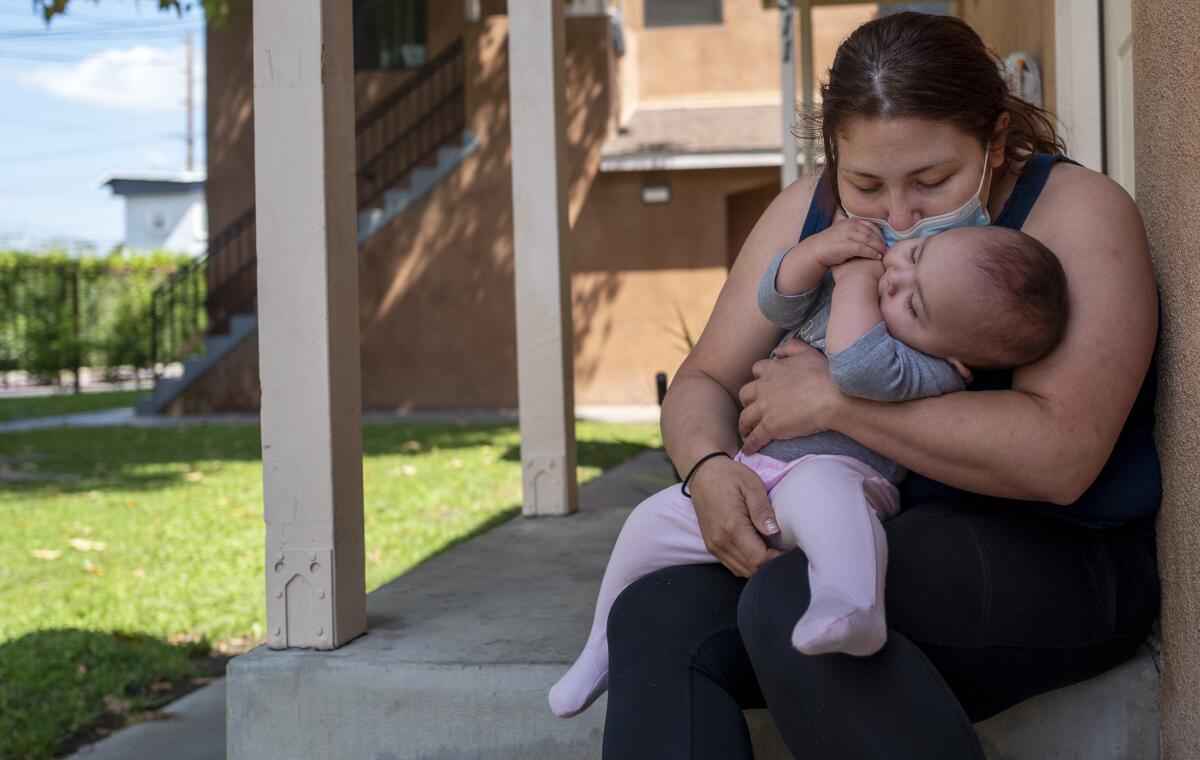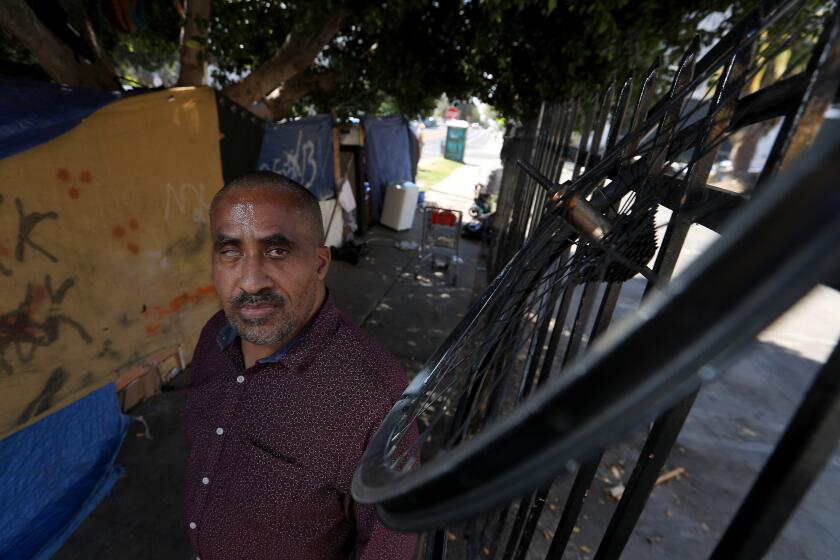Homeless and addicted, they hit bottom. Now they’re on the verge of breaking free

- Share via
The road to recovery at the small cluster of buildings on 52nd Street in South Los Angeles begins at rock bottom, winds through courthouses and jails, and passes through the rings of hell.
Women of all ages arrive in damaged condition, spirits broken, having lost it all. They have no jobs, no homes, no family support, and no solid reason to believe anything is ever going to change.
Valerie, 39, told me she was molested throughout her childhood by a stepfather, ran away as a teenager and was raped and beaten during years of homelessness.
Jasmin, 27, said she was dominated by a boyfriend who used her as a punching bag, broke her nose and pushed her in front of a moving vehicle. She finally ran for her life one day when the brute was out of the house and begged a stranger to help whisk her to safety.
La Donna, 58, said her father whipped her with a belt and battered her mother so severely, he once broke her jaw. As an adult, La Donna ended up with a man who specialized in mental abuse. He mocked her and repeatedly referred to her as a dummy. “Oh, I hated that word,” said La Donna.
Valerie, Jasmin and La Donna have different stories but two things in common.
‘It always felt to me like I’d fallen off a fire escape,” says Yale graduate Shawn Pleasants, “and once you get on the ground, the ladder is 12 feet up in the air.’
They became homeless and they became addicted, La Donna to crack, Valerie and Jasmin to methamphetamine. Drugs deadened the pain of the past, made it easier to cope with the present, and helped make more tolerable the absence of hope for a better future. And such is the story with nearly all the women at this Wesley Health Center residential rehab house.
“They all come from poverty, lack of education and employment, generational trauma,” said Nora O’Connor, director of behavioral health programs.
It’s a place where women come straight out of jail, with rehab as a condition of their release. Or they enter the program because a child has been removed from their custody and drug treatment is a part of their case plan. The general length of stay is 60-120 days, followed by 180 days in what’s referred to as bridge housing. Wesley, a part of the JWCH Institute, contracts with L.A. County and bills Medi-Cal and MyHealthLA.
O’Connor has worked in rehab for 25 years, with stints on skid row, San Francisco’s Tenderloin and at a high-end private program in Malibu. For clients of the latter, she said, “the main difference is having the resources and money to not end up in jail, and to hide the problem for a longer period of time.”
There’s no such luxury for her clients at Wesley, where the stories are a reminder that in L.A. County’s homeless population of about 60,000, poverty, addiction and mental illness are often intertwined. Two weeks ago, I wrote about a Yale grad and Wall Street banker who lost everything and became homeless for six years, with a crippling meth addiction. He’s now sober and housed, and I’m still trying to find out more about how people become addicted, and how they recover.
There’s plenty of out-patient counseling available in Los Angeles, but that’s a tricky proposition for homeless clients who can’t escape the causes or temptations of drug use. Residential treatment, for many, represents the best chance of beating drugs.
“When they first arrive, it’s all about building up their self-esteem,” said O’Connor.
For many of the women, some of whom have given up on themselves, it’s hard to make a commitment at first. When you walk through the door, you pass from a life without rules to one with nothing but. You must surrender your phone, you’re out of bed by 6 a.m., your day is filled with structured drug and mental health counseling and activities, and it’s lights out at 10:15 p.m.
Some leave and never come back. Some first make a mad dash, then end up asking to get back in. And many of the women make it through and begin the hard work of rebuilding their lives. That last part brings them right back to some of the very things that sent them into their spirals in the first place — L.A.’s extreme shortage of affordable housing and good-paying, low-skilled jobs.
Gary Tsai, director of substance abuse prevention and control for L.A. County, said that on paper, residential treatment slots are always available. But not necessarily in the locations where they’re needed at any given moment, and he’s working on developing a more flexible, accommodating system. Given the teeming population of addicted homeless people, he said, more beds would help.
But meth addiction is particularly hard to treat, said Tsai. The drug is cheap, and it produces a huge dopamine release, which makes for a high that can last for a day or more. Tsai said there currently is no reliable substitution therapy, such as drug treatments available for opiates. So the protocol is behavior therapy and counseling.
But the vast majority of addicts either don’t want treatment or don’t think they need it, Tsai said.
“The 90% of the people who don’t want it but need it are the ones we need to reach,” he said.
One way to do that is with more intensive outreach and case management. Another way may be to open safe-use sites, which I mentioned in a recent column. SB 57 is a legislative proposal that borrows from safe-use, overdose-prevention models in parts of Europe, where addiction is addressed as a public health crisis rather than a criminal problem. Clients can use in a supervised setting and be linked to counseling and rehab services.
La Donna, who got into a fight while high on meth and spent a month in jail, where she was diagnosed with a mental illness, told me she likes the safe-use idea.
“If you could offer a recovery program instead of jail,” she said, that at least puts you on the right path.“ But first you’ve got to be willing to go to a place like that.”
When she arrived at Wesley, La Donna wasn’t betting on herself. She called her attitude “nasty,” and she wasn’t even convinced she was an addict. But she’s now completed four months in the residential program and recommitted for a longer stay.
“I don’t crave drugs now that I’m behind these walls,” La Donna said. “But I don’t feel strong enough to go out there yet.”
Jasmin got pregnant while homeless, but her baby was born with meth and marijuana in her system and was removed from her custody. She arrived at Wesley last June, spent six months in the residential program, and has logged five more in bridge housing. Her child, Destiny, now lives with her and is her motivation to stay clean. Jasmin told me she hasn’t felt this good in years.
“I love being a mom. I enjoy every minute of it, waking up next to her and being with her for everything she does,” Jasmin said as she cuddled her cooing baby, who just took her first steps several days ago. “I had no love, no attention, no support. I want her to have everything I didn’t have.”
Valerie has her own success story to tell. Her child, too, was removed from her custody. When the child was sent to live in the same house where Valerie had been abused as a child, Valerie says, she told the judge there wasn’t a question of if she would get her child back, but when. She went through the residential program and moved on to sober living, and now has custody of her child.
Valerie wore a short-sleeve shirt when I spoke to her, revealing ladders of deep scars on both arms. She said they’ve been there since the days when she was molested.
“I used to cut myself to feel that,” she said, “instead of the pain of what I was going through.”
The meth helped, too. For a while.
“I lived in fear,” she said of her years on the streets, and meth kept her awake at night to ward off attacks. “I’d get an instant feeling of euphoria. The only feeling I would have would be happiness.”
Valerie said she was diagnosed with manic depression, and she has nightmares in which her child has been taken away again. She wakes up from those dreams recommitted to her recovery.
We generally associate addiction with weakness. But talking to these women, I saw nothing but strength. The strength needed to survive what they went through, and to believe they can break through to something better.
For women who arrive at the recovery house doubtful that they’ll ever make a clean break from drugs and despair, an employee named Natividad Diaz is a beacon of hope. Diaz, who helps the women find permanent housing after they complete the program, was herself a client after 25 years of addiction and homelessness. Diaz told me she was assaulted and raped, spent time in jail and prison, flunked several rehab attempts, and then something clicked.
“I was dying when I came here,” Diaz said, but she was finally ready to be as good at recovery as she had been at hustling.
She now lives in a rented house, is looking to buy, and is raising her three children on her own.
“I wanted to be normal. I didn’t want to be up all night, tweaking, and doing my hustle,” said Diaz.
There’s hope.
More to Read
Sign up for Essential California
The most important California stories and recommendations in your inbox every morning.
You may occasionally receive promotional content from the Los Angeles Times.















